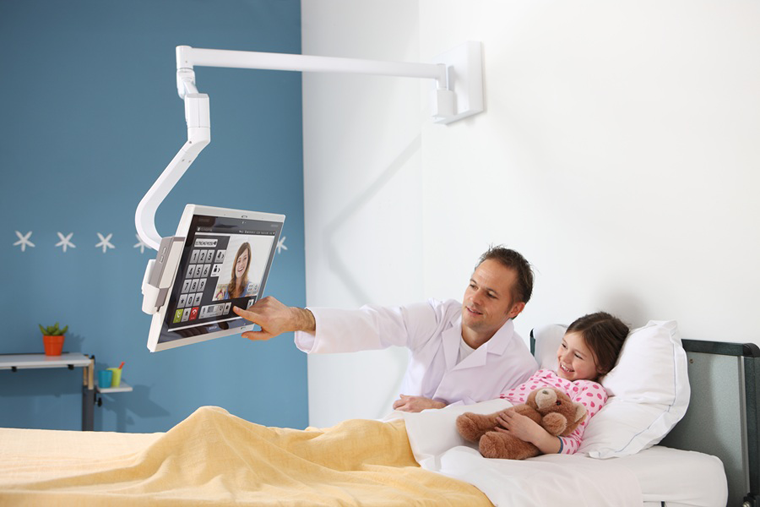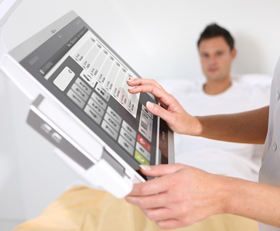Bedside Infotainment: Patient Accommodations Get Interactive

Credit: Barco
For all the advances in healthcare technology, one key area has remained largely unchanged for the past 40 years: patient accommodations.
“Most patient rooms today still have only a television and a telephone, which leaves patients with very little in the way of activities to keep them occupied or stay in touch with friends and family,” says Carole Ireland, director of sales, point of care at Barco Healthcare. “In today's world, where people are used to having smartphones and notebooks and being continually connected, entertained and informed, the lack of technology inside a patient room can be a real frustration point for patients.”
Fortunately, there's a new and increasingly popular tool that can help hospitals revolutionize this aspect of patient care and satisfaction - while also enabling them to meet many of their own clinical, operational and administrative needs.
The bedside infotainment terminal, as it's generally known, brings together a computer, television, phone and nurse call button into a single, easy-to-use, touch-screen product that provides patients with a quantum leap of entertainment, communication, self-service and education options.
In addition, the terminal is a clinical tool that physicians, nurses and other providers can use to access patient information, explain medical conditions and treatments to their patients, and directly input orders, notes and instructions.
Enabling Convenience and Independence
Keeping patients entertained and connected might, on the surface, seem trivial, but in the larger scheme of treating illness and injury and saving lives, its role in effective patient care should not be discounted, according to Jennifer Covich Bordenick, CEO of eHealth Initiative.
“It can be very isolating and stressful to be in a hospital for any length of time,” she states. “So anything that hospitals can do to engage the patient, make life a little easier and more interesting, and keep them in touch with friends and family not only helps improve their experience but also can reduce their overall stress levels, give them a more positive outlook and help them feel better.”
Bedside infotainment terminals provide patients with the following functionalities:
-
Entertainment: With a bedside terminal, patients can, among other things, download on-demand, new-release movies and videos, surf the web, keep up with local and national news, play games, listen to music or shop online. Patients who have been cleared to do so by their physicians can even conduct work-related and personal tasks, such as checking their e-mail or paying online bills.
-
Communication: Patients can use the terminal to communicate with their nurses and make traditional phone calls, but they also have many other communication choices. They can chat without holding the handset to their ear by using the speaker. They can make a conference call and provide a single health update to several family members and friends at once or use the webcam to video conference or video chat. A patient can also post messages to a CaringBridge or other medical update page or engage with friends using their social networking tools.
-
Self-Service: Integrated with other systems, a bedside terminal can help patients take care of many basic needs - without involving a nurse. For example, a patient can use the terminal to control the room temperature, turn down the lights, or open and shut automated blinds and curtains. Most popularly, patients can use the terminal to directly access the hospital's meal-ordering system, view a menu that takes into account their physician-cleared dietary needs and communicate their requests.
Facilitating Better Lines of Communication
Another use for bedside terminals is education. Healthcare providers can use the devices to push out videos and personalized instructions to patients to help them understand their medical condition, what they'll need to do to care for themselves once they get back home, what symptoms should be cause for concern and how to safely take and manage their prescriptions.

Credit: Barco
The patient education function is increasingly important, says Bordenick, because of the trend toward shorter hospital stays and more outpatient surgeries and procedures.
“More responsibility is being pushed onto the patient to care for themselves shortly after an illness or treatment,” she explains. “And we've condensed the timeline that doctors and nurses are available to these patients to explain how to perform that care.”
A bedside terminal trumps other communication methods because the screen is right in front of patients, the instructions are personalized to patients' unique needs, the presentation is often interactive and patients can review the information as often and as comprehensively as they want.
All of these features help engage patients and their caregivers and help them better understand and retain the information.
The Clinical Benefits of Bedside Terminals
For clinicians, the bedside terminal negates the need to memorize patient details or lug a computing device from room to room. The bedside system can be integrated with back-end healthcare applications, including electronic health records, electronic prescribing, picture archiving and communication systems, and computerized physician/provider order entry systems.
With the Barco product, clinicians can access all clinical applications and patient information by tapping their RFID-enabled badge to the terminal and then entering a second required login. At that point, they have access to everything they need to consult with and treat the patient.
Nurses can input vitals as soon as they finish taking them, for example, while a physician can show the patient an X-ray or test results, e-prescribe a medication, order a test, provide release information via the hospital information system or call in the nurse. All of this saves time, reduces errors and improves efficiency.
The Bottom Line
Bedside infotainment terminals, integrated with clinical and hospital information applications, can also provide a wide range of potential benefits to healthcare administrators, including improved patient experience, reduced maintenance on existing televisions and telephones and increased clinician efficiency and workflow.
The system is especially useful in freeing up overworked and stressed nurses to spend more time on clinical tasks, rather than running back and forth to patient rooms or dealing with a patient's personal - rather than medical - needs. And all of that can improve their energy levels and increase their job satisfaction, which helps hospitals recruit and retain top-quality personnel in the face of a critical nursing shortage.
“This technology really represents the ultimate 'two-fer,' because just about everything within the terminal offers a dual benefit,” states Ireland. “It's good for the patient and their experience, of course, but it also offers those productivity solutions on the back end, as well as an improved ability for the hospital to meet their regulatory requirements, improve their patient satisfaction scores and lower their readmission rates. We expect 2013 to be the year this technology really takes off because it solves so many problems - puts checkmarks in so many boxes.”







